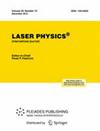A selective and sensitive mercury sensor for drinking water based on fluorescence quenching of pure rhodamine B
IF 1.1
4区 物理与天体物理
Q4 OPTICS
引用次数: 0
Abstract
The escalating threat of industrial pollutants, particularly heavy metals, in water sources poses a significant risk to global populations. Among these heavy metals, mercury stands out as a severe contaminant with detrimental health implications. This paper introduces a novel and efficient method for the selective detection of mercury ions in drinking water, employing laser-induced fluorescence with pure rhodamine B as the sensing probe. The method achieves a low detection limit of 7 ppb, closely approaching the World Health Organization’s maximum permissible limit. The simplicity of the procedure, coupled with the use of pure rhodamine B, distinguishes this approach from others relying on complex chemical procedures and derivatives of rhodamine B. The sensing mechanism involves the fluorescence quenching of rhodamine B due to complex formation with tetraiodomercurate. Noteworthy is the method’s selectivity, demonstrated by its resistance to interference from common ions present in water (e.g. Magnesium, calcium, sodium, and potassium), ensuring accurate detection of mercury ions. Extensive testing with tap water samples, considering potential interference, validates the robustness of the sensor, with recovery percentages of 99.25% and 109.2%. In summary, this study contributes a practical solution to the critical challenge of mercury detection in drinking water, addressing issues of sensitivity, selectivity, and on-site applicability. The proposed method holds promise for widespread implementation, enhancing efforts to safeguard public health and ensure the safety of water resources.基于纯罗丹明 B 荧光淬灭的饮用水选择性灵敏汞传感器
水源中工业污染物,特别是重金属的威胁不断升级,给全球人口带来了巨大风险。在这些重金属中,汞是一种对健康有害的严重污染物。本文介绍了一种选择性检测饮用水中汞离子的新型高效方法,该方法采用纯罗丹明 B 激光诱导荧光作为传感探针。该方法的检测限低至 7 ppb,接近世界卫生组织规定的最高允许限。该方法的传感机制包括罗丹明 B 与四碘化汞形成络合物而导致的荧光淬灭。值得注意的是,该方法的选择性很强,能抵抗水中常见离子(如镁、钙、钠和钾)的干扰,确保准确检测汞离子。考虑到潜在的干扰,对自来水样本进行了广泛的测试,验证了传感器的稳健性,回收率分别为 99.25% 和 109.2%。总之,这项研究为解决饮用水中汞检测的关键难题提供了一个实用的解决方案,解决了灵敏度、选择性和现场适用性等问题。所提出的方法有望得到广泛应用,从而加强保障公众健康和确保水资源安全的工作。
本文章由计算机程序翻译,如有差异,请以英文原文为准。
求助全文
约1分钟内获得全文
求助全文
来源期刊

Laser Physics
物理-光学
CiteScore
2.60
自引率
8.30%
发文量
127
审稿时长
2.2 months
期刊介绍:
Laser Physics offers a comprehensive view of theoretical and experimental laser research and applications. Articles cover every aspect of modern laser physics and quantum electronics, emphasizing physical effects in various media (solid, gaseous, liquid) leading to the generation of laser radiation; peculiarities of propagation of laser radiation; problems involving impact of laser radiation on various substances and the emerging physical effects, including coherent ones; the applied use of lasers and laser spectroscopy; the processing and storage of information; and more.
The full list of subject areas covered is as follows:
-physics of lasers-
fibre optics and fibre lasers-
quantum optics and quantum information science-
ultrafast optics and strong-field physics-
nonlinear optics-
physics of cold trapped atoms-
laser methods in chemistry, biology, medicine and ecology-
laser spectroscopy-
novel laser materials and lasers-
optics of nanomaterials-
interaction of laser radiation with matter-
laser interaction with solids-
photonics
 求助内容:
求助内容: 应助结果提醒方式:
应助结果提醒方式:


